|
DICTIONARY OF AMERICAN NAVAL AVIATION SQUADRONS—Volume 2
Chronology of Significant Events
First VP-48
Established as VP-208 on December 15th, 1942
Redesignated VPB-208 on October 1st, 1944
Redesignated VP-208 on May 15th, 1946
Redesignated VP-MS-8 on November 15th, 1946
Redesignated VP-48 on September 1st, 1948
Disestablished on December 31st, 1949
15 Dec 1942: VP-208 was established at NAS Norfolk, Virginia, as a seaplane squadron flying the PBM-3C Mariner. During this period the squadron came under the operational control of FAW-5. Due to the holidays, squadron personnel did not begin the training syllabus until 4 January 1943. On the 17th the first aircraft were received and flight familiarization training commenced.
Feb–10 Mar 1943: VP-208 was relocated to NAS Corpus Christi, Texas, for shake-down training, remaining under the operational control of FAW-5. Training was concluded on 10 March 1943.
12 Mar 1943: VP-208 reported aboard at NAS Key West, Florida, for training under the operational control of FAW-12. The squadron was assigned new PBM-3S aircraft with improved radar.
15 Apr 1943: The squadron commenced its first operational patrols from an advanced base at Pelican Harbor, British West Indies, supported by the tender USS Christiana (YAG-32).
15 Nov 1943: VP-208 relocated to Grand Cayman, B.W.I., remaining there until 1 May 1944.
8 May–30 Jul 1944: VP-208 relocated to another advanced base at Royal Island, B.W.I., supported by USS Christiana (YAG-32). The squadron remained at this location until the end of July, when the squadron was transferred to NAS Norfolk, Virginia, on 30 July 1944.
Aug 1944: Following the relocation to NAS Norfolk, Virginia, the squadron was given home leave. VP-208 refitted at NAS Norfolk, Virginia, and received new aircraft, the PBM-5 Mariner on 22 August. Training on the new airframe continued at NAS Norfolk, Virginia through the first week of September.
7 Sep 1944: VP-208 relocated to NAAS Harvey Point, North Carolina, for further operational and predeployment training which continued until the end of October.
4–15 Nov 1944: The squadron was deemed ready for deployment and began the transcontinental flight from NAAS Harvey Point, North Carolina to NAS Alameda, California, where it came briefly under the operational control of FAW-8. The flight crews and ground staff took two weeks to thoroughly overhaul the aircraft for the pending transpac to NAS Kaneohe Bay, Hawaii.
30 Nov 1944: The aircrews departed NAS Alameda, California for NAS Kaneohe Bay, Hawaii, in three aircraft elements. The ground support staff, equipment and supplies for the squadron proceeded aboard USS Attu (CVE-102). All personnel were aboard NAS Kaneohe Bay, Hawaii by 8 December, coming under the operational control of FAW-2. Training in ASW and aerial gunnery commenced immediately. Crews received practical experience conducting operational patrols off the Hawaiian Islands.
8 Feb 1945: VPB-208 reported to FAW-1 at NAS Tanapag Harbor, Saipan, Marianas Islands. Duties at this location consisted of antishipping patrols and reconnaissance.
25 Feb 1945: The squadron relocated to the waters off Ulithi, reporting with 13 serviceable aircraft. Tender support was provided by USS Castle Rock (AVP-35), USS Casco (AVP-12), and USS Suisun (AVP-53).
16 Mar 1945: A relatively rare bombing mission was scheduled for the squadron when it was selected to bomb the Japanese airfield on Yap Island. The chance of any encounter with enemy aircraft was almost nonexistent, as by this time in the war virtually all Japanese air assets had been eliminated in that theater of operations. Ground fire from these isolated outposts, however, was often exceptionally heavy and accurate, bringing down many unwary U.S. aircraft before the conclusion of hostilities.
20 Mar–21 Jun 1945: Twenty-one officers and 67 enlisted personnel departed for Guam to board USS Hamlin (AV-15) for transport to Kerama Rhetto Island, Nansei Shoto. The Okinawa campaign had begun on 18 March, and Kerama Rhetto was occupied on 25 to 26 March. The first VPB-208 Mariner landed offshore on 31 March. The tender-based patrol squadrons conducted long-range antishipping searches over the East China Sea to protect assault forces from enemy surface force interference, flew antisubmarine patrols in the combat area, and provided air-sea rescue services for carrier operations through the end of the campaign on 21 June 1945.
14 Jul 1945: VPB-208 departed Kerama Rhetto for Chimu Wan, Okinawa, supported by the USS Hamlin (AV-15). The last wartime operational flight was made from this location on 11 August 1945. On the 15th the aircrews boarded USS Kenneth Whiting (AV-14) and USS Corson (AVP-37) en route to its next duty station, Tokyo Bay, Japan.
31 Aug 1945: VPB-208 took off from Chimu Wan, Okinawa, and flew north to Tokyo Bay to participate in duties with the U.S. occupation forces in Japan.
31 Dec 1949: VP-48 was disestablished.
HOME PORT ASSIGNMENTS
NAS Norfolk, Virginia
15 Dec 1942
NAS Corpus Christi, Texas
1 Feb 1943
NAS Key West, Florida
12 Mar 1943
NAS Norfolk, Virginia
30 Jul 1944
NAAS Harvey Point, North Carolina
7 Sep 1944
NAS Alameda, California
Nov 1944
NAS Kaneohe Bay, Hawaii
Dec 1944
Toyko Bay, Yokosuka Naval Base, Japan
Aug 1945
NAS Norfolk, Virginia
3 Jan 1946
NAS Jacksonville, Florida
May 1946
NAS Trinidad, British West Indies.
Sep 1946
COMMANDING OFFICERS
LCDR D. C. Goodman
15 Dec 1942
LCDR Anton J. Sintic, Jr.
19 Nov 1943
LCDR William T. Sutherland
4 Nov 1945
CDR Robert D. Cox, Jr.
Feb 1947
CDR William S. Guest
20 Mar 1948
CDR Alto B. Clark
29 Jun 1949
AIRCRAFT ASSIGNMENT
PBM-3C
Dec 1942
PBM-3S
Mar 1943
PBM-5
Aug 1944
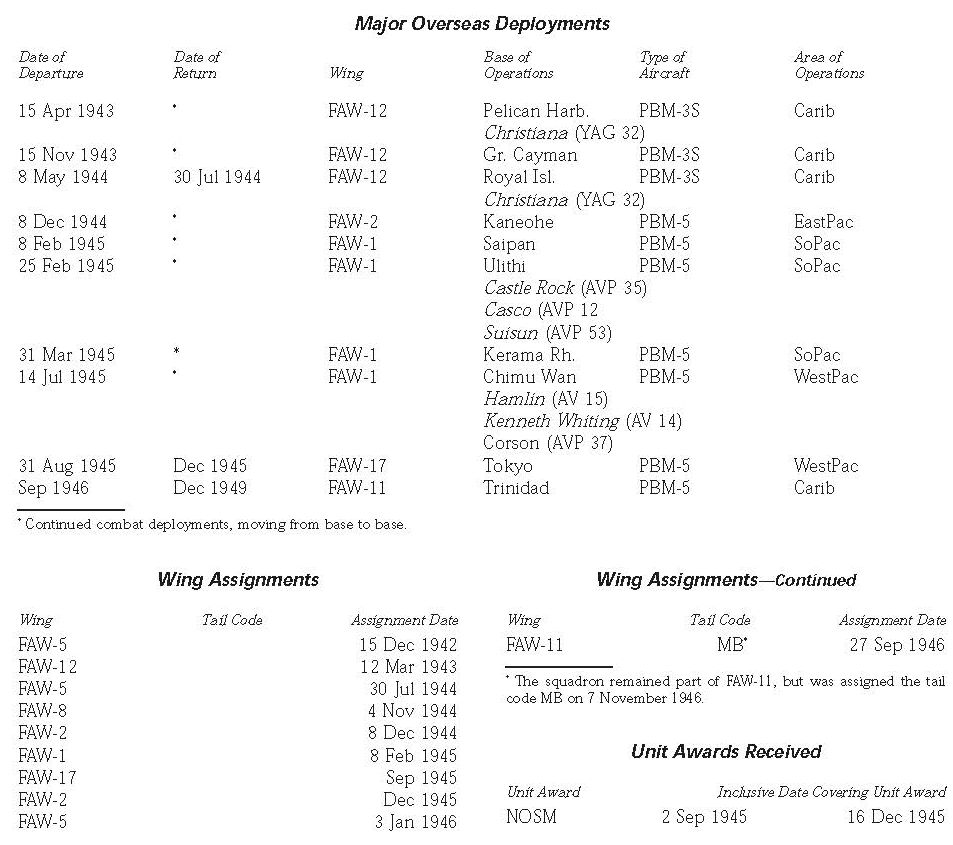
=================================
Second VP-48
Established as Reserve VP-905 on May 1946
Redesignated VP-HL-51 on November 15th, 1946
Redesignated Reserve VP-731 on February 1950
Redesignated VP-48 on February 4th, 1953
Disestablished on May 23rd, 1991
May 1946: VP-905 was established at NAS Grosse ILE, Michigan, with an official active duty home port at NAS San Diego, California. The squadron came under the operational control of FAW-14 and administrative control of the Naval Air Reserve Training Command (NARTC). The squadron was one of 21 reserve squadrons established after the war to accommodate the large number of aircrews recently released from active duty and utilize the enormous stocks of aircraft in the inventory. The squadron flew the PBY-5A Catalina seaplane and the PV-2 Harpoon.
15 Nov 1946: All patrol squadrons were redesignated. Regular Navy squadron designations began with 1 and reserve patrol squadron designations began with 5. VP-905 was redesignated VP-ML-55. The ML for reserve patrol squadrons included twin-engine medium amphibian seaplanes, as well as twin-engine land-based bombers. Regular Navy patrol squadron ML designations were for twin-engine medium landbased bombers only. Amphibian medium seaplanes like the PBY-5A were in the AM category.
Feb 1950: VP-ML-55 was redesignated VP-731 during the reorganization of Naval Aviation reserve units in 1949, but did not take effect until February 1950. During this period the number of Naval Aviation Reserve squadrons was reduced from the 1949 total of 24 to 9. By this date the squadron had transitioned to the PBM-5 Mariner.
29 Sep 1950: VP-731 was called to active duty as a result of North Korean forces invading the Republic of Korea on 25 June 1950. The squadron reported for duty to Commander Naval Air Force Pacific Fleet at NAS San Diego, California. At the start of hostilities Navy patrol forces on active duty numbered just 20 squadrons and it quickly became apparent that this rather meager figure was inadequate to meet the increased demands. By the end of 1950 seven reserve patrol squadrons were called to active duty to augment the regular Navy patrol squadrons.
7 Feb 1951: VP-731 deployed to Naval Base Buckner Bay, Okinawa, supported by USS Suisun (AVP-53). A detachment was maintained at NS Sangley Point, Philippines, supported by USS Salisbury Sound (AV-13). Both sections conducted patrols over the Formosa Straits and China coast. A single aircraft was detached to Hong Kong to provide courier service between Hong Kong and the R.P. 29 May 1952: VP-731 began its second WestPac deployment based at MCAS Iwakuni, Japan, supported by USS Kenneth Whiting (AV-14) and USS Gardiners Bay (AVP-39). The squadron began combat operations over the Korean coastline on 1 June 1952. During the deployment the squadron alternated between Korea and the Formosa patrol area.
31 Jul 1952: A PBM-5S2 Mariner flown by Lieutenant E. E. Bartlett, Jr., was attacked by two Chinese MiG-15 fighters while on a reconnaissance patrol over the Yellow Sea off the west coast of Korea. Two crewmen were killed in the attack, tail gunner Aviation Machinist Mate H. G. Goodroad and Airman Claude Playforth. Two other crewmen were seriously wounded. Lieutenant Bartlett was able to escape the MiGs and land his heavily damaged Mariner at Paengnyong-do, South Korea. Temporary repairs were made, enabling him to return to base at Iwakuni, Japan.
Jul 1953: VP-48 began its third WestPac deployment to Korea just as the hostilities ceased on 27 July 1953. The squadron was based at NAF Iwakuni, Japan, supported by USS Kenneth Whiting (AV-14) and USS Gardiners Bay (AVP-39). During a patrol on 30 July the port engine of a squadron PBM-5S2 caught fire causing the plane to crash. Only five of the 15 personnel on board survived and were picked up by a Coast Guard PBM.
Jun 1954: VP-48 transitioned from the PBM-5S2 Mariner to the Martin P5M-1 Marlin seaplane.
3 May 1956: Two VP-48 Marlins en route from NAS North Island, San Diego, California to NAS Pearl Harbor, Hawaii, ditched due to low fuel state. One aircraft was taken under tow by a USCG vessel. The carrier USS Wasp (CV-18) stood by until the tender USS Pine Island (AV-12) arrived to retrieve the second aircraft.
22 Oct 1957: VP-48 deployed to MCAS Iwakuni, Japan. While transiting via Hawaii, two aircraft were detached by Commander Fleet Air Hawaii for evaluation of an experimental seaplane fueling buoy. The two aircraft rejoined the squadron at MCAS Iwakuni, Japan on 2 November 1957.
19 Mar–Sep 1964: The squadron made its first deployment in over four years to WestPac, relieving VP-40 at NS Sangley Point, Philippines. In the last month of the deployment, on 2 August 1964, the Gulf of Tonkin Incident brought VP-48 into the South China Sea to support fleet operations. During these operations the squadron accumulated over 1,500 hours on patrol.
1 Oct 1965–Sep 1966: VP-48 deployed a six-aircraft detachment to NS Sangley Point, Philippines, rotating one relief crew and associated ground personnel to the detachment on a monthly basis. During the deployment the detachment conducted surveillance patrols over the South China Sea and Operation Market Time patrols over coastal Vietnam. While conducting these patrols the squadron was provided tender support at NAF Cam Ranh Bay, Vietnam, by USS Pine Island (AV-12), and after February 1966, USS Salisbury Sound (AV-13). When operating from Naval Base Buckner Bay, Okinawa, the squadron was supported by USS Currituck (AV-7). The six aircraft that had been operated by the VP-48 detachment were transferred to VP-50 upon the conclusion of the deployment.
15 Nov 1966–Apr 1967: VP-48 transitioned to the P-3A Orion and a permanent change of station to NAS Moffett Field, California. Effective 15 February 1967, VP-48 was administratively assigned to FAW-10 vice FAW-14. The squadron received its first P-3A on 23 January 1967. The final detachment of squadron personnel was transferred from NAS North Island, San Diego, California in April 1967.
24 Jul 1967–31 Jan 1968: VP-48 deployed to MCAS Iwakuni, Japan, relieving VP-4. A two-aircraft detachment conducted operations from Guam and Midway islands. Additional detachments were maintained at NS Sangley Point, Philippines, in support of Vietnam combat missions.
On 16 January 1968, a P-3A, BuNo. 152144, was lost and the entire crew killed in an accident. On 23 January 1968, the squadron commenced 24-hour ASW protection for USS Enterprise (CVAN-65) Task Force in the Sea of Japan. The task force had been brought into the area as a result of the Pueblo Incident. USS Pueblo (AGER-2) was an intelligence monitoring ship that was seized by the North Koreans in international waters. The squadron returned to NAS Moffett Field, California in February 1968 and began transitioning to the P-3B Orion.
1 Dec 1968: VP-48 deployed to NAS Adak, Alaska. The squadron earned a Meritorious Unit Citation for its performance in tracking Soviet naval units during the deployment.
1 Apr 1970: VP-48 deployed to NS Sangley Point, Philippines, with a detachment at NAF Cam Ranh Bay, Vietnam. The detachment was responsible for detecting eight enemy trawlers attempting to ship arms and munitions to the Viet Cong. VP-48’s performance during the deployment earned it a Meritorious Unit Commendation.
1 May 1971: VP-48 deployed to NS Sangley Point, Philippines, with a three-aircraft/four-crew detachment at U-Tapao Royal Thailand Air Force Base, Thailand. On 25 May, upon the closure of NS Sangley Point, Philippines, the squadron relocated to NAS Cubi Point, Philippines.
23 Jun–Dec 1972: VP-48 began a three-way split deployment with one detachment of three aircraft/four crews at NAS Adak, Alaska; a second detachment of three aircraft/four crews at NAS Agana, Guam; and the remaining three aircraft/ four crews at NAS Moffett Field, California. The NAS Agana, Guam detachment had an interesting one week assignment in December tracking Russian missile instrumentation ships and watching two Soviet missiles impact in the Soviet Missile Range landing zone.
10 Jul 1978: VP-48 deployed to NAF Misawa, Japan. Shortly after arrival at NAF Misawa, Japan, the squadron was forced to fly away in the face of Typhoon Virginia to NAS Cubi Point, Philippines.
10 Nov 1979: VP-48 deployed to NAF Kadena, Okinawa, Japan, with a detachment at NSF Diego Garcia. During the deployment the squadron played an important role in locating Vietnamese refugee boats for rescue units. The NSF Diego Garcia detachment was on constant standby during the Iranian Crisis resulting from the overthrow of the Shah of Iran on 4 November 1979.
2 Dec 1985–May 1986: VP-48 deployed to NAS Adak, Alaska. On 7 May a major earthquake (7.7 Richter scale) struck while several squadron aircraft were airborne. The squadron executive officer communicated with the aircraft using a handheld transceiver until communications could be restored and the runways certified safe for landing.
Jul 1986: The squadron’s P-3C baseline Orions began block modification to the P-3C MOD version with new inertial navigation systems, secure HF radios and Harpoon missile capability.
15 Jun 1990: The Boomers deployed a three-aircraft and four-aircrew detachment to NAF Kadena, Okinawa, Japan. In Aug 1990, the detachment was relocated to NAS Cubi Point, Philippines, in support of Operation Desert Storm.
23 May 1991: VP-48 was disestablished at NAS Moffett Field, California.
HOME PORT ASSIGNMENTS
NAS Grosse ILE, Michigan
May 1946
NAS San Diego, California / NAS North Island, San Diego, California*
29 Sep 1950
NAS Moffett Field, California
15 Feb 1967
NAS San Diego, California was redesignated NAS North Island, California in 1955.
COMMANDING OFFICERS
Unknown
1946–1949
LCDR H. S. Wilson
1950
LCDR W. T. O’Dowd, Jr.
1951
CDR F. G. Vessell
1953
CDR J. C. Young
1954
CDR J. F. Davis
1955
CDR Robert C. Payne
1956
CDR Harry A. Haszard
20 May 1958
CDR K. M. E. Miller
10 Jun 1959
CDR A. D. Ronimus
30 Jun 1960
CDR Rae P. Madson
30 Jun 1961
CDR Warren E. Zaiser
6 Jul 1962
CDR K. E. Bailey
10 Jun 1963
CDR C. J. McGrath
1964
CDR William M. Shaver
7 Apr 1965
CDR Clarence O. Robins
26 Apr 1966
CDR Donald J. Childers
25 Apr 1967
CDR Paul J. Tetreault
22 Mar 1968
CDR Eugene G. Anderson
30 Apr 1969
CDR David B. Pitts
23 Apr 1970
CDR George S. Phillips
8 Apr 1971
CDR Myles E. Fladager
15 Apr 1972
CDR Daniel T. O’Donnell
1973
CDR Thadeus W. Mills
1974
CDR Michael A Pearce
25 Mar 1975
CDR John G. Burton
30 Apr 1976
CDR John W. Ciboci
22 Apr 1977
CDR William T. Boyd III
21 Apr 1978
CDR Duval S. Woodford
9 Mar 1979
CDR Edward J. Crowley
25 Apr 1980
CDR L. J. LeDoux
10 Aug 1981
CDR R. S. Parodi
1982
CDR J. S. Falls
8 Jul 1983
CDR D. L. Speed
15 Oct 1984
CDR Gregory A. Bushnell
8 Nov 1985
CDR Charles P. Isele
1986
CDR Robert M. Lunning
2 Oct 1987
CDR Richard Fleming, Jr.
30 Sep 1988
CDR R. H. Fisher
17 Jul 1989
CDR Chalker W. Brown III
25 May 1990
AIRCRAFT ASSIGNMENT
PBY-5A/PV-2
May 1946
PBM-5S2
1950
P5M-1
Jun 1954
SP-5B
1960
P-3A
Jan 1967
P-3B
Feb 1968
P-3C
Nov 1971
P-3C
MOD Jul 1986
P-3C
UIII Jan 1990
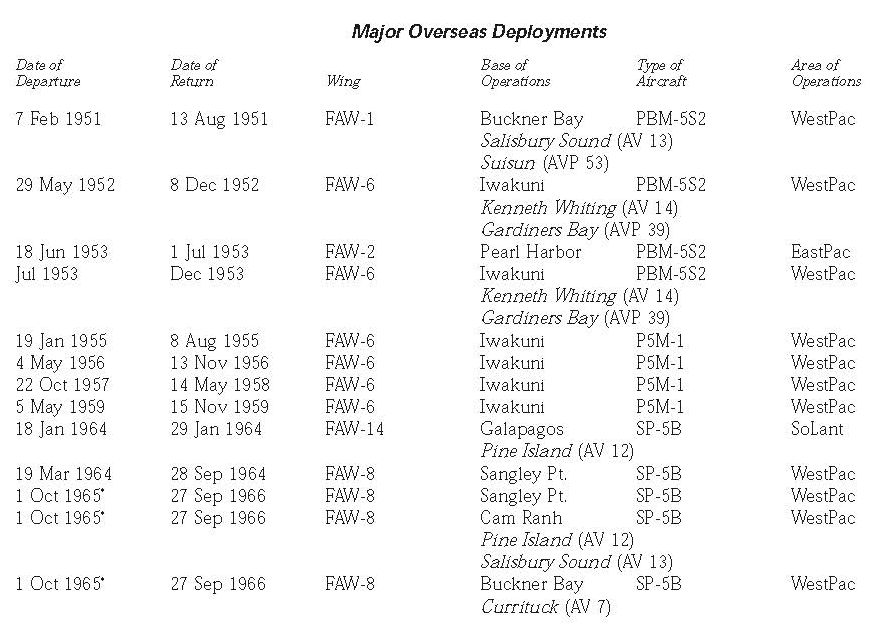
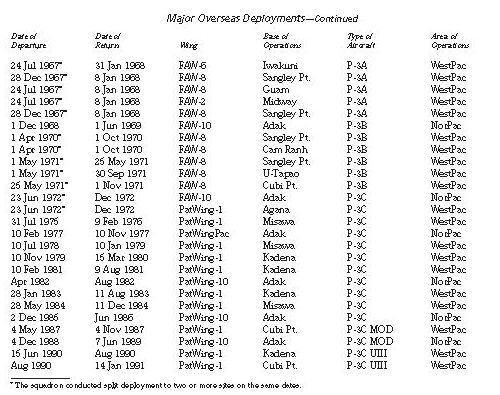

=================================
Flying the PBM, VP-731 reported to COMNAVAIRPAC for active duty on Oct 2 1950. The squadron completed two WESTPAC tours and began a third during the Korean conflict. For its operation in the Korea and Formosa Patrol areas, VP-731 was awarded the Korean Presidential Unit Citation. In Feb 1953 VP-731 was re-designated VP-48. In June 1954 the squadron completed the transition to the P5M Marlin aircraft. VP-48 earned the Captain A.J. Isbell Trophy for ASW Excellence in 1959 and 1960, the first two years it was offered. The squadron also captured the Battle Excellency “E” for Fleet competition in 1960. In March 1964, VP-48 deployed to NS Sangley Point, Philippines. Notable accomplishments on the WESTPAC tour were the 1000+ hours flight time logged in both June and July. During the S.E. Asia crisis of August, VP-48 outdid its own record - and every other seaplane squadrons all-time record - by amassing 1585 hours flight time as it wove a month-long ASW web around the Naval Forces embarked in the South China Sea. In flying around the clock, VP-48 averaged two planes airborne at all times for an entire month. In Sept 1964 the squadron returned to NAS North Island, San Diego, California. In spite of the heavy operational requirements during 1964 the squadrons flag football team won the 11th Naval District championship and the NAS North Island, San Diego, California championship for the fifth year in a row. The team boasted a record of 78 wins to one lose dating back to 1959. In 1965 VP-48 returned to NS Sangley Point, Philippines with a six plane detachment in support of “Operation Market Time.”
In September 1966 VP-48 transitioned to the P-3 Orion and moved from NAS North Island, San Diego, California. to NAS Moffett Field, California. In March VP-48 was once again awarded the COMNAVAIRPAC Battle Efficiency “E” for the year 1966 and also the Captain Arnold J Isbell Trophy for 1965-1966.
During 1967-1968, VP-48 deployed to MCAS Iwakuni, Japan and NAS Adak, Alaska respectively. The Meritorious Unit Commendation was awarded for the squadrons patrol efforts during the NAS Adak, Alaska deployment. In March they again received the Battle Efficiency “E” and deployed the following month to NS Sangley Point, Philippines. During the next six months, with a detachment at NAF Cam Ranh Bay, Vietnam the squadron flew “Market Time” patrols over the South China Sea. Returning to NAS Moffett Field, California In October. In May 1971 the squadron returned to NS Sangley Point, Philippines and NAS Cubi Point, Philippines with a detachment at U-Tapao Royal Thailand Air Force Base, Thailand, flying OSAP’s as part of Seventh Fleet operations. VP-48 returned from WESTPAC in November 1971 to transition to the new P-3C aircraft. On December 3rd the squadron was presented the Battle Efficiency “E” and the Captain Isbell Trophy for 1970-1971. The Meritorious Unit Commendation was also awarded for the 1970 deployment along with the CNO Maintenance Award and the Royal Air Force Coastal Command Trophy. The squadron has held the COMNAVAIRPAC Quarterly Safety five times in the last thirteen years. Beginning in 1972 the squadron participated in the “Tri-Detachment” deployment with detachments at NAS Adak, Alaska, NAS Agana, Guam, and NAS Moffett Field, California. During this era, VP-48 saw every tasking known to the P-3 community, from subtime to MEDEVAC and Air Sea Rescue. All this was accomplished from bases several thousand miles apart, in weather that ranged from artic ice and cold to the heat and humidity of the tropics. VP-48 was disestablished May 23rd 1991.
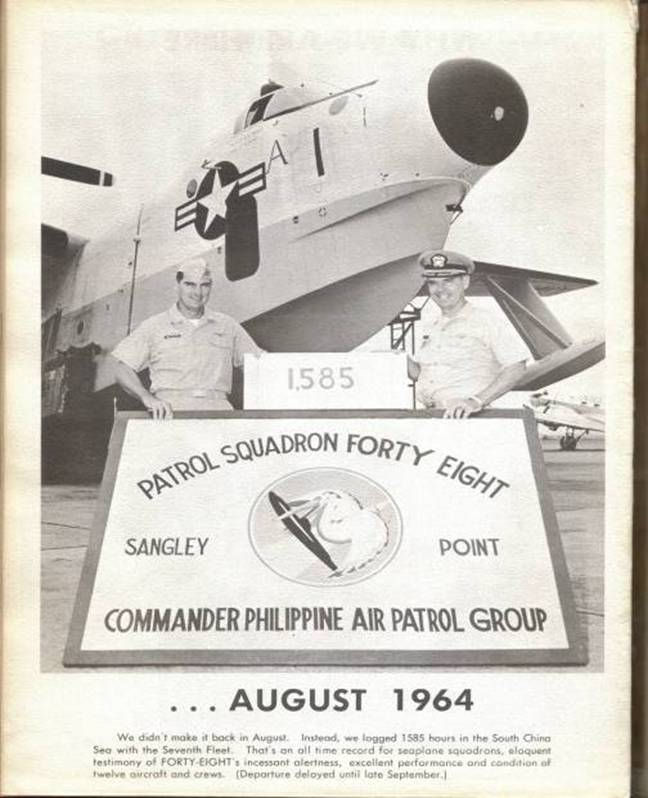
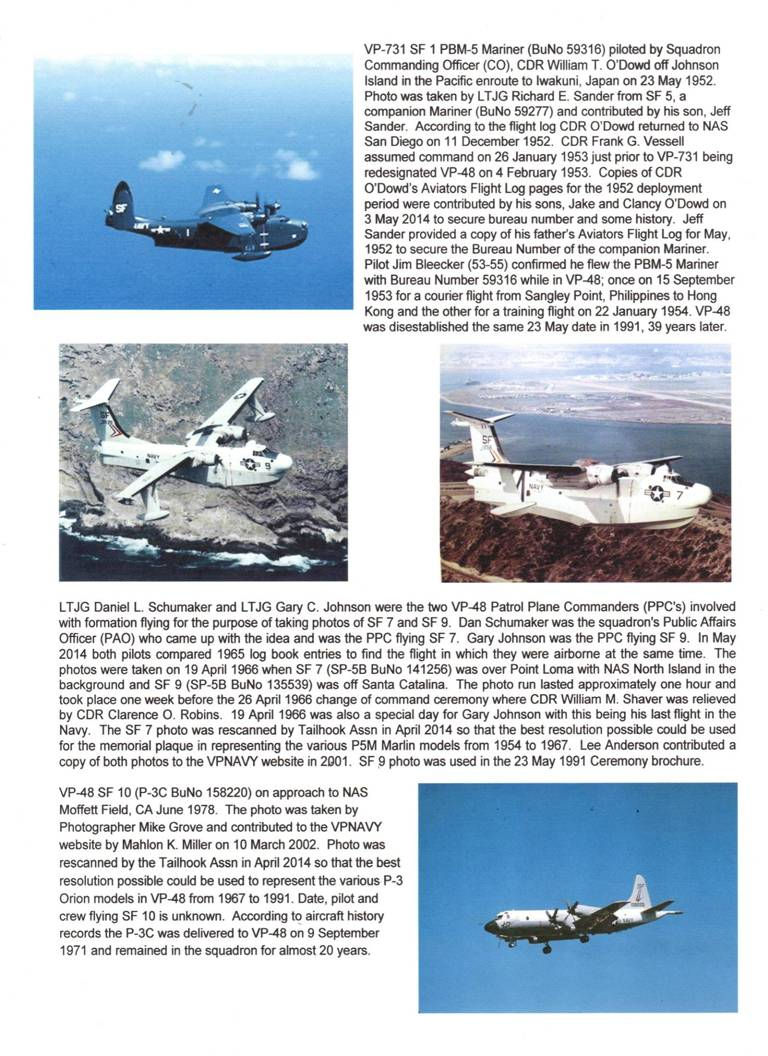
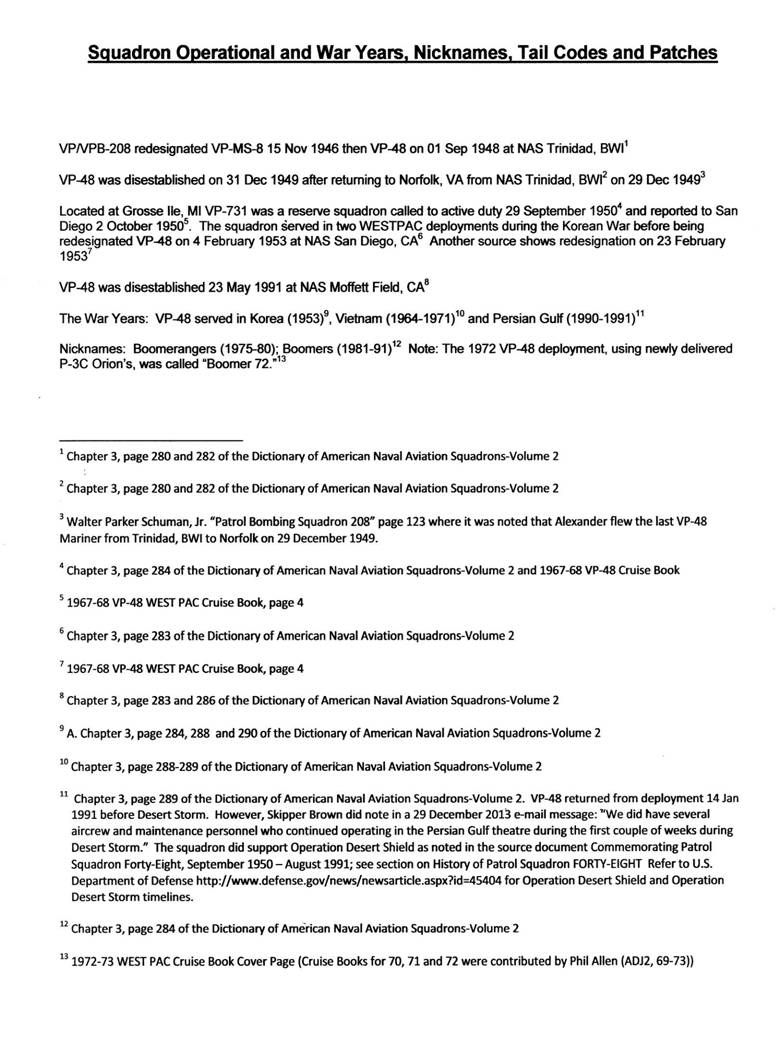
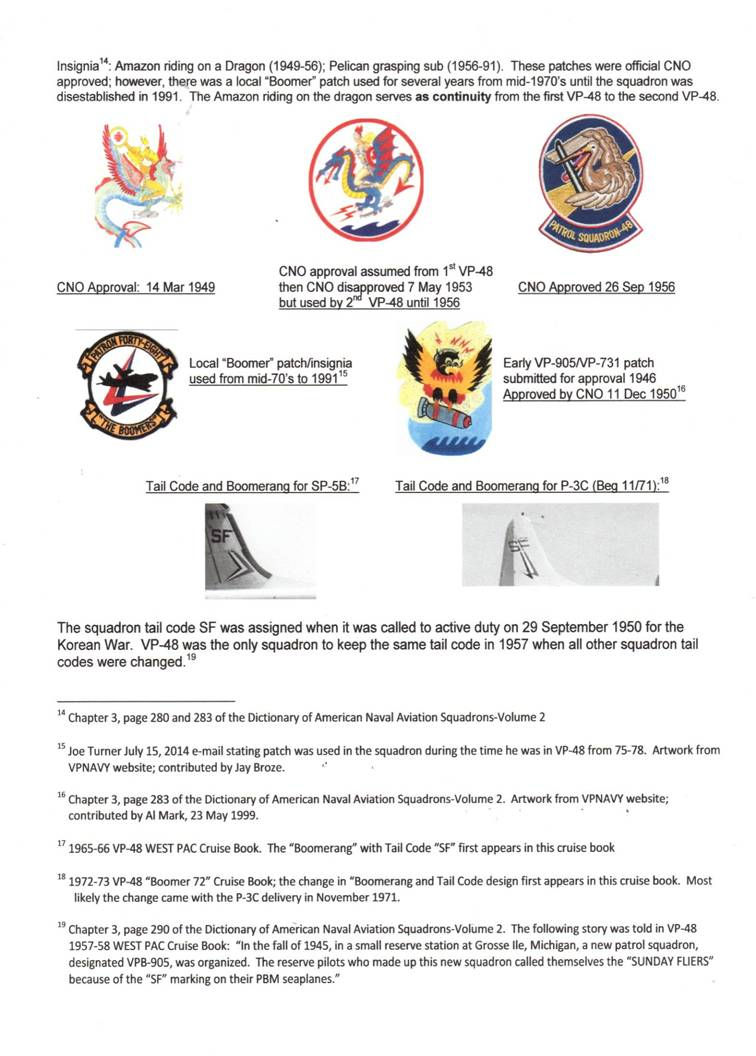
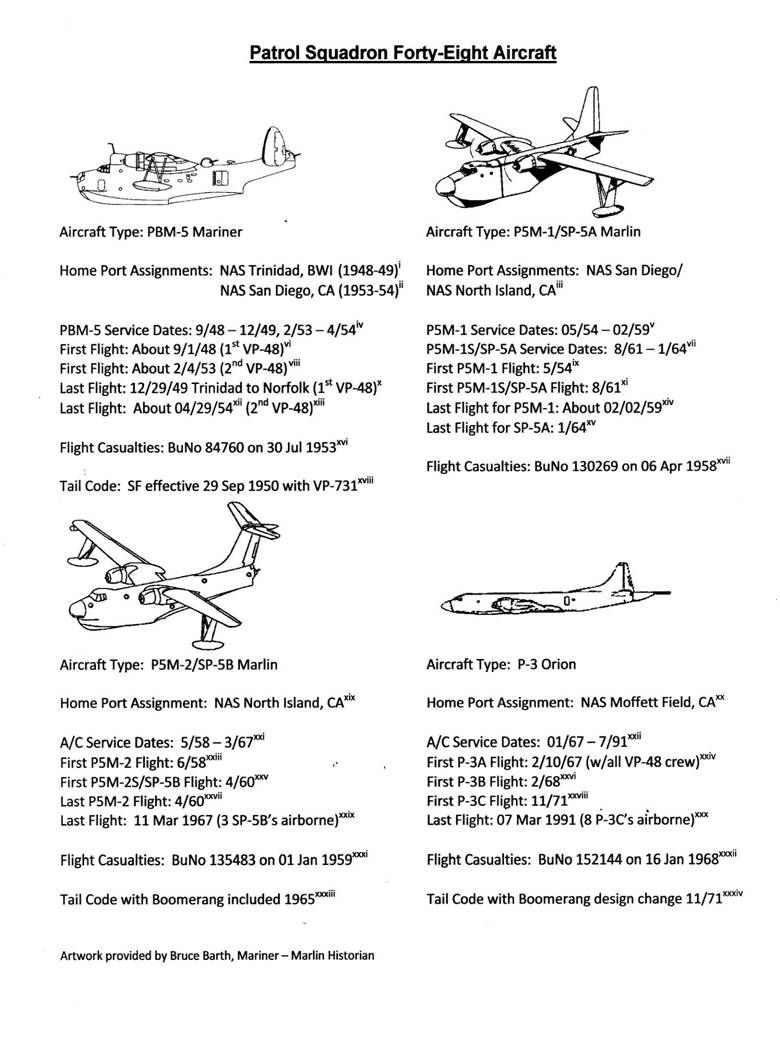
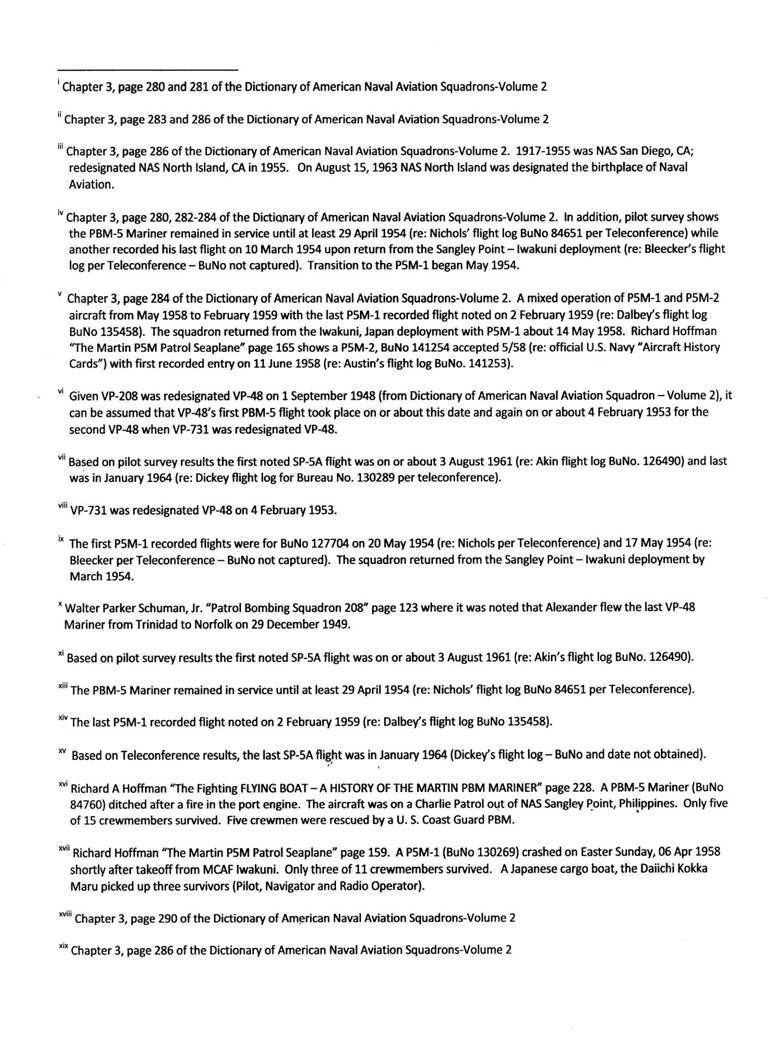
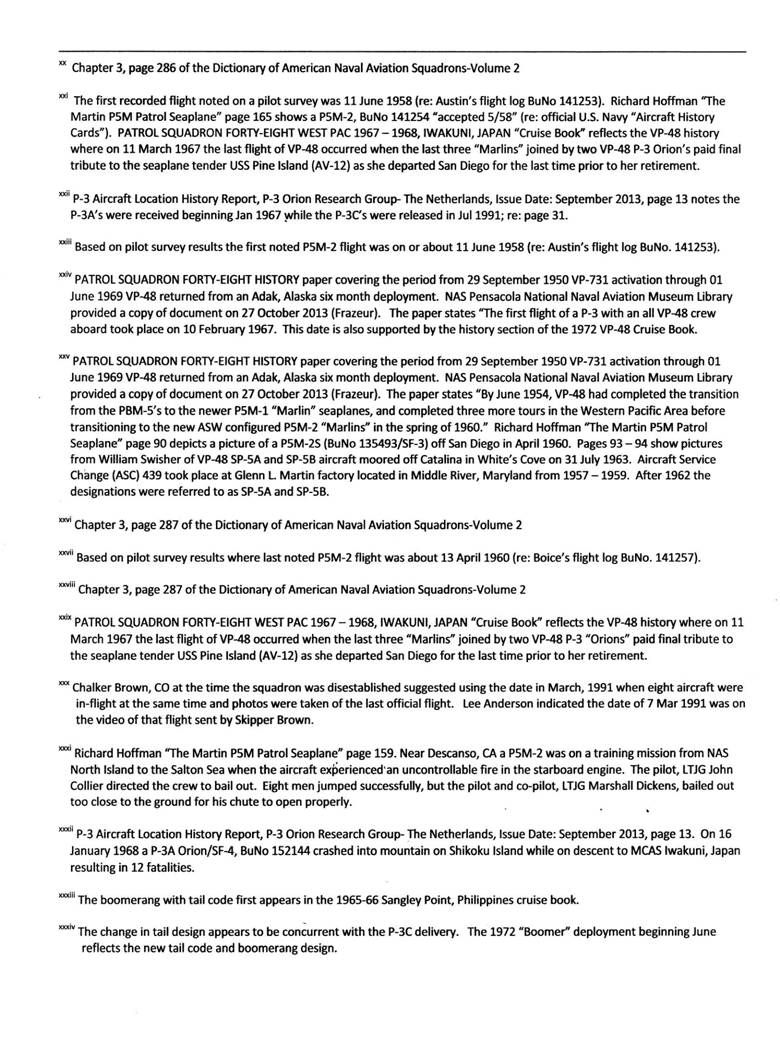
Last VP-48 Flight Schedule For SP5/P5M Type Aircraft
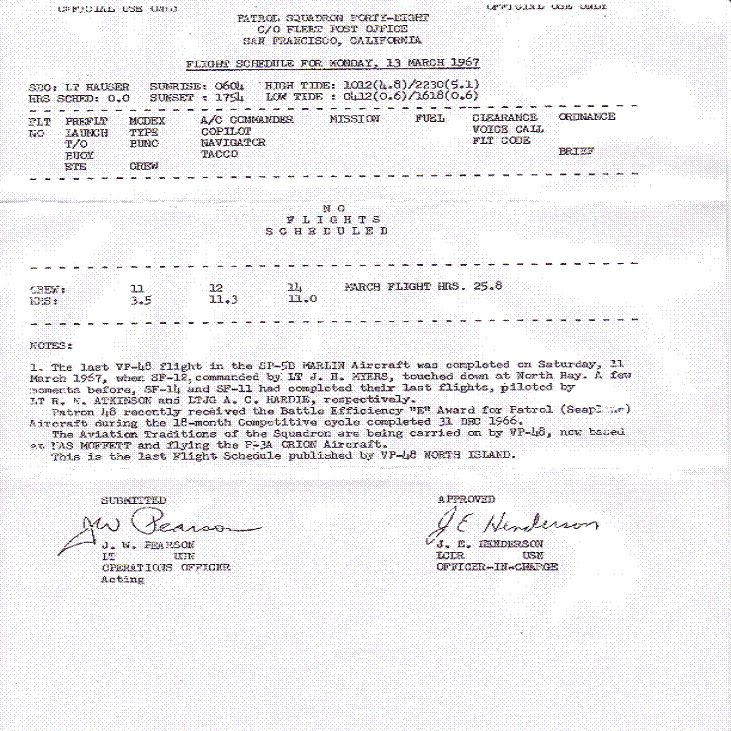
Menu and Event Schedule
Club Orient 1964
Submitted by: AMH3 John Morris
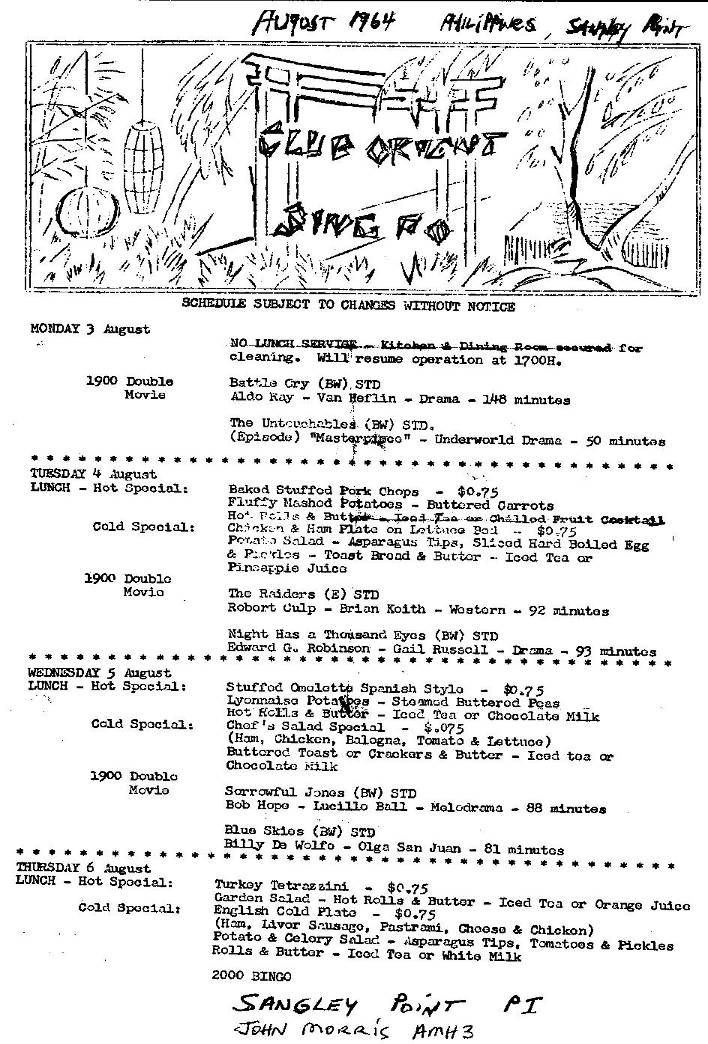
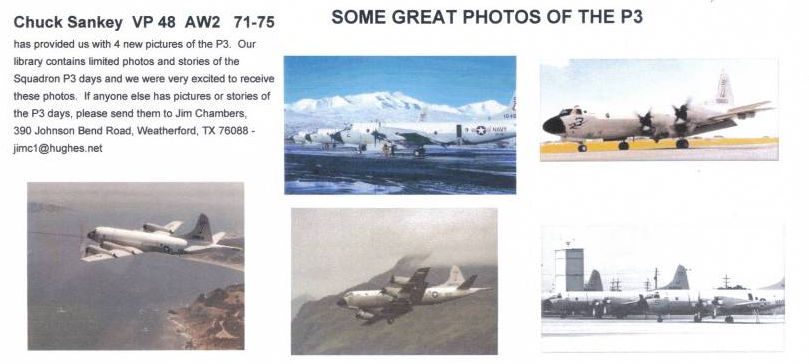
|
